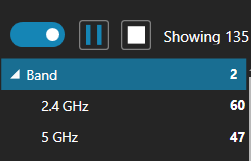Differences between the 2.4GHz and 5GHz band.
By simple definition, frequency bands are ranges of radio wave frequencies used to transmit data in the wireless spectrum, and can further be broken down into WiFi channels.
There are basically two frequency bands used for Wi-Fi technology, 2.4GHz, and 5GHz. The 2.4GHz has been around longer. It’s also an unregulated frequency. As a result, vendors can manufacture 2.4GHz devices less expensively than a regulated spectrum like the 5GHz band. The downside to this “unregulated” band is that manufacturers use it for everything: cordless phones, baby monitors, microwaves, garage door openers, etc. 5GHz is a regulated frequency which costs manufacturers more to produce.
The 2.4GHz band offers a better range. It handles obstacles better than 5.0GHz. However, 5GHz offers much faster throughput for maximum performance. It just doesn’t handle obstructions and channel noise quite as well. However, keep in mind that because there are more 2.4GHz wireless networks, the frequency channels can become crowded in some areas.
Interference and obstructions greatly affect the range and quality of a wireless signal.
Remember this when troubleshooting because it may not be just one thing causing problems. It could be that there are too many devices using the same frequency.
Use WiFi Scanner to check and see what frequency you are using and to filter by that frequency to see who else is using it!

